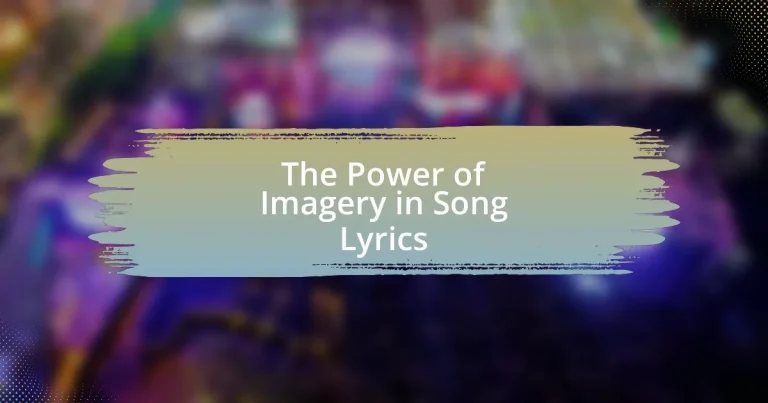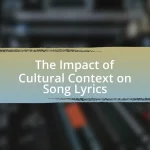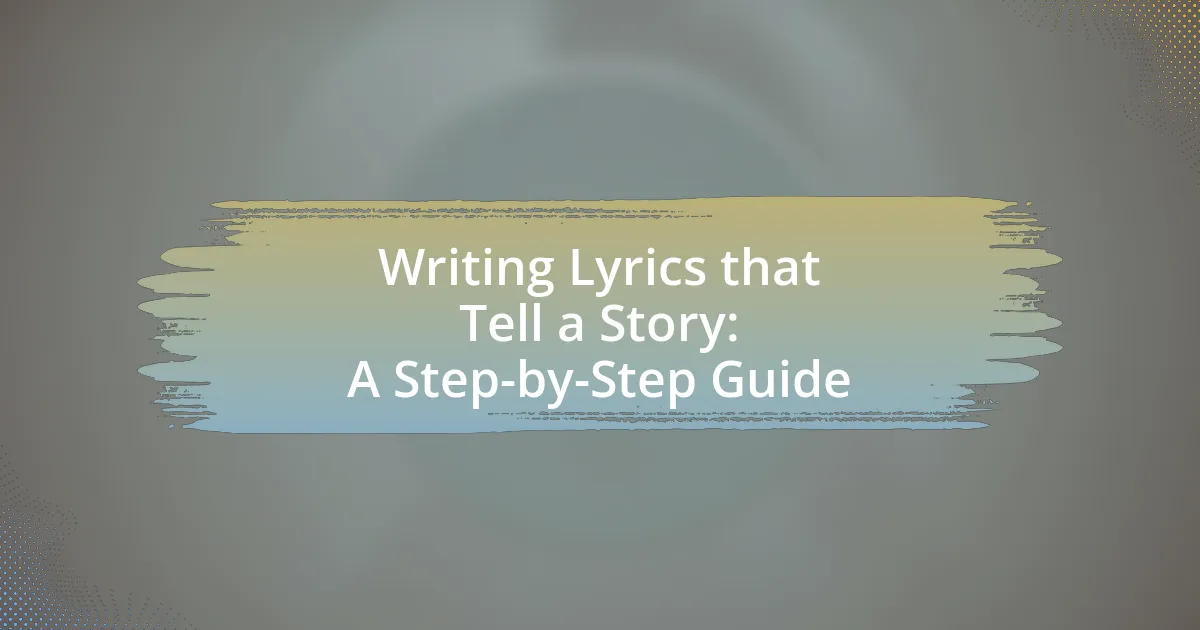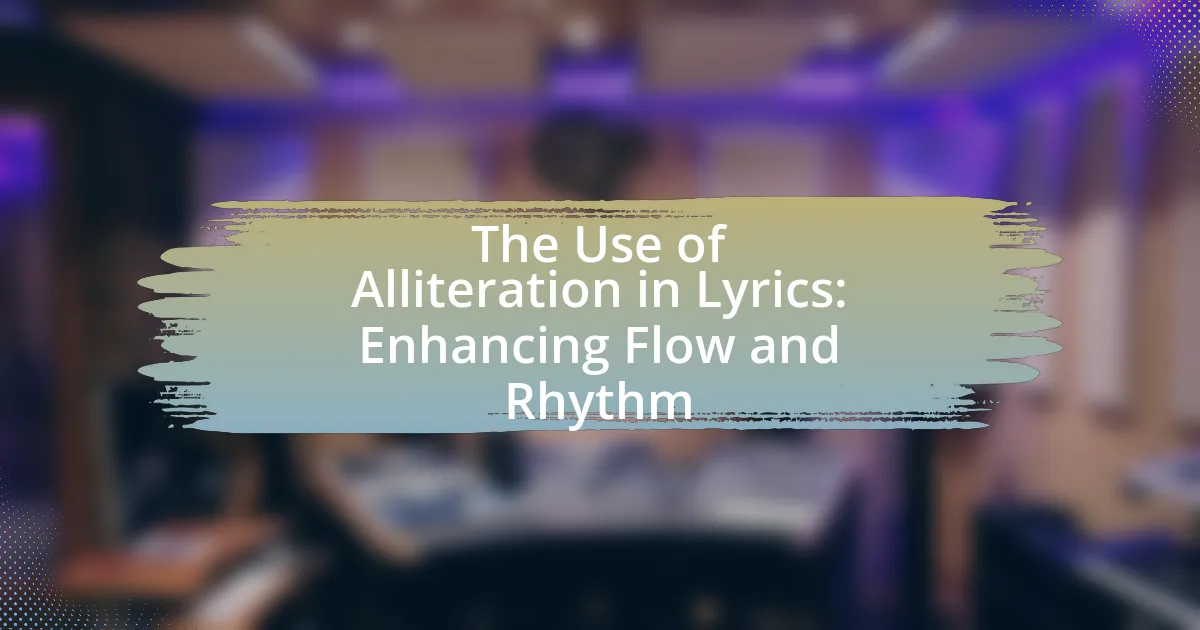The article explores the significance of imagery in song lyrics, highlighting its ability to evoke emotions and create vivid mental pictures that resonate with listeners. It discusses how imagery enhances emotional impact, storytelling, and listener engagement through various types such as visual, auditory, tactile, olfactory, and gustatory imagery. The article also examines the techniques songwriters use to create effective imagery, the challenges they face, and the importance of balancing clarity with creativity. Additionally, it addresses how cultural context influences interpretation and provides practical tips for enhancing imagery in songwriting.
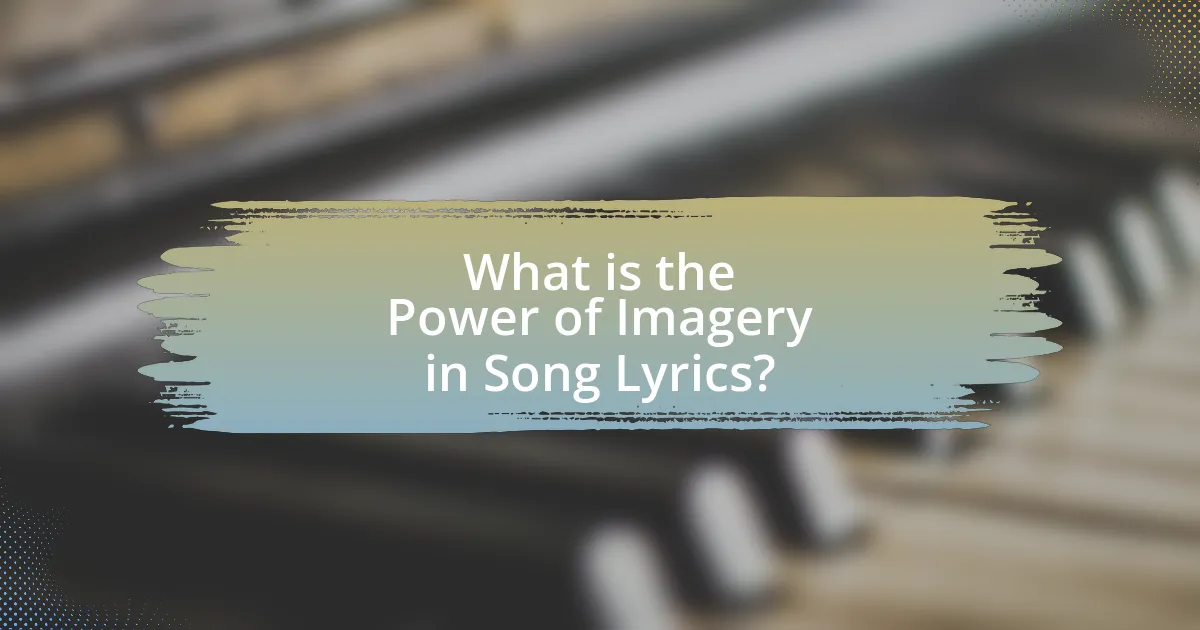
What is the Power of Imagery in Song Lyrics?
The power of imagery in song lyrics lies in its ability to evoke emotions and create vivid mental pictures that resonate with listeners. Imagery enhances the storytelling aspect of songs, allowing artists to convey complex feelings and experiences through descriptive language. For instance, Bob Dylan’s use of imagery in “Blowin’ in the Wind” paints a poignant picture of social issues, making the message more impactful. Studies show that songs with strong imagery can lead to greater emotional engagement, as listeners can visualize and relate to the scenarios presented, thereby deepening their connection to the music.
How does imagery enhance the emotional impact of song lyrics?
Imagery enhances the emotional impact of song lyrics by creating vivid mental pictures that evoke strong feelings in listeners. When songwriters use descriptive language and sensory details, they allow listeners to connect emotionally with the narrative or themes presented in the lyrics. For example, a lyric that describes a sunset can evoke feelings of nostalgia or longing, while imagery related to heartbreak can elicit sadness or empathy. Research indicates that songs with rich imagery are often more memorable and resonate more deeply with audiences, as they engage the imagination and emotions simultaneously. This connection is supported by studies showing that emotionally charged lyrics can lead to increased listener engagement and a stronger overall impact of the song.
What types of imagery are commonly used in song lyrics?
Common types of imagery used in song lyrics include visual, auditory, tactile, olfactory, and gustatory imagery. Visual imagery evokes pictures in the listener’s mind, often describing scenes, colors, or emotions, while auditory imagery relates to sounds and music, enhancing the lyrical experience. Tactile imagery appeals to the sense of touch, olfactory imagery engages the sense of smell, and gustatory imagery relates to taste, creating a multi-sensory experience. These types of imagery are frequently employed by songwriters to evoke emotions and create vivid scenes, making the lyrics more relatable and impactful. For example, in Bob Dylan’s “Blowin’ in the Wind,” visual imagery is used to paint a picture of social issues, while auditory imagery can be found in the rhythmic patterns of the lyrics.
How do different imagery types affect listener interpretation?
Different imagery types significantly influence listener interpretation by evoking specific emotions and mental images. For instance, visual imagery can create vivid scenes that enhance emotional connection, while auditory imagery can evoke sounds that resonate with personal experiences. Research indicates that songs utilizing rich imagery lead to deeper engagement and varied interpretations among listeners, as demonstrated in a study by Hargreaves and North (1999), which found that imagery in lyrics can alter emotional responses and meaning-making processes. Thus, the type of imagery employed in song lyrics directly shapes how listeners perceive and relate to the music.
Why is imagery important in songwriting?
Imagery is important in songwriting because it evokes emotions and paints vivid pictures in the listener’s mind, enhancing their connection to the song. By using descriptive language and sensory details, songwriters can create relatable experiences that resonate with audiences. For instance, songs like “Firework” by Katy Perry utilize imagery to convey themes of empowerment and self-discovery, making the message more impactful. This technique not only engages listeners but also helps them visualize the narrative, leading to a deeper emotional response and a lasting impression.
How does imagery contribute to storytelling in songs?
Imagery enhances storytelling in songs by creating vivid mental pictures that evoke emotions and connect listeners to the narrative. This technique allows songwriters to convey complex themes and experiences through descriptive language, making the story more relatable and impactful. For instance, in Bob Dylan’s “A Hard Rain’s A-Gonna Fall,” the use of striking imagery illustrates the weight of societal issues, engaging the audience’s imagination and deepening their understanding of the song’s message. Such imagery not only enriches the lyrical content but also fosters a stronger emotional response, reinforcing the overall storytelling experience in music.
What role does imagery play in creating memorable hooks?
Imagery plays a crucial role in creating memorable hooks by evoking vivid mental pictures that resonate with listeners. This vividness enhances emotional engagement, making the hook more relatable and impactful. For instance, songs that utilize strong imagery, such as “Firework” by Katy Perry, create a visual representation of empowerment and self-worth, which helps the hook stick in the listener’s mind. Research indicates that imagery in lyrics can increase recall and emotional response, as demonstrated in studies on music cognition, where listeners reported stronger connections to songs with rich visual language.
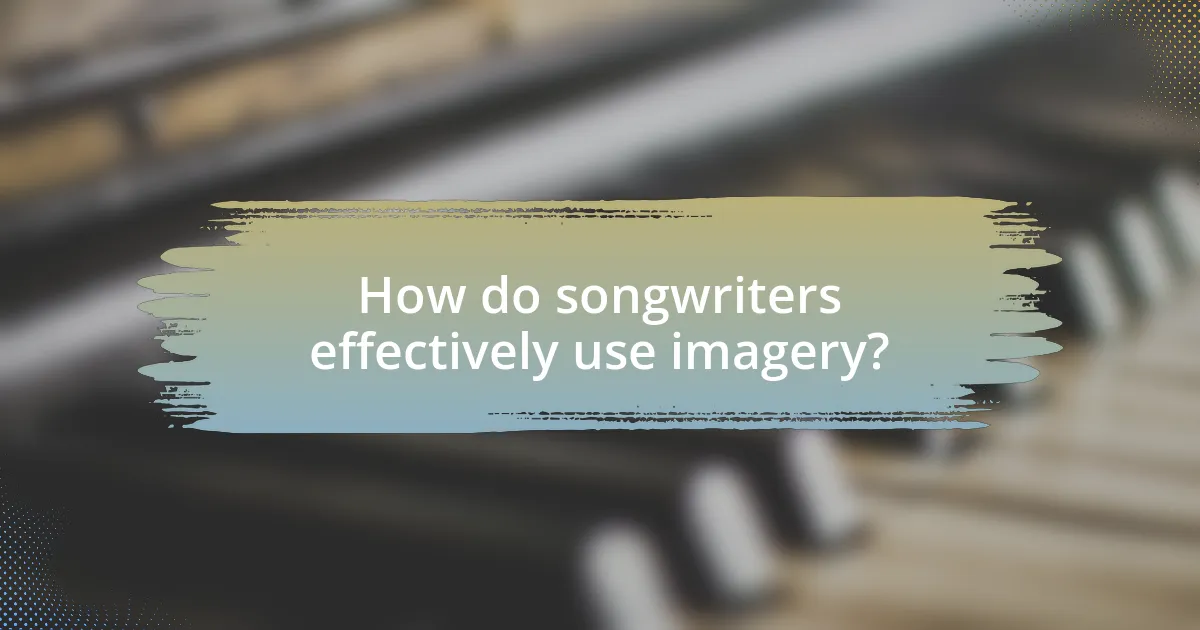
How do songwriters effectively use imagery?
Songwriters effectively use imagery by creating vivid mental pictures that evoke emotions and enhance the listener’s experience. This technique allows them to convey complex feelings and narratives through descriptive language, making their lyrics more relatable and impactful. For instance, in Bob Dylan’s “Blowin’ in the Wind,” the imagery of the wind symbolizes elusive answers to profound questions, engaging listeners on a deeper level. Research indicates that imagery in lyrics can significantly increase emotional engagement, as demonstrated in a study published in the Journal of Music Therapy, which found that songs with strong imagery led to heightened emotional responses in participants.
What techniques do songwriters employ to create vivid imagery?
Songwriters employ techniques such as metaphor, simile, sensory details, and personification to create vivid imagery. Metaphors and similes draw comparisons that evoke strong visual associations, allowing listeners to visualize concepts more clearly. For example, describing love as a “rose with thorns” conveys beauty intertwined with pain. Sensory details engage the audience’s senses, painting a more immersive picture; phrases like “the scent of rain on dry earth” evoke specific smells and feelings. Personification attributes human qualities to non-human elements, making scenes more relatable, such as “the wind whispered secrets.” These techniques enhance emotional connection and visualization, making lyrics more impactful.
How does metaphor enhance imagery in lyrics?
Metaphor enhances imagery in lyrics by creating vivid and relatable comparisons that evoke strong visual and emotional responses. By linking abstract concepts to concrete images, metaphors allow listeners to visualize experiences and feelings in a more impactful way. For instance, when a lyric describes love as a “burning fire,” it conjures a specific image that conveys intensity and passion, making the emotion more tangible. This technique is supported by studies in cognitive linguistics, which show that metaphors shape our understanding and perception of the world, thus enriching the lyrical experience.
What is the significance of sensory details in songwriting?
Sensory details in songwriting are significant because they create vivid imagery that enhances emotional connection and listener engagement. By incorporating sensory elements such as sight, sound, taste, touch, and smell, songwriters can evoke specific feelings and memories, making the lyrics more relatable and impactful. For instance, a study published in the Journal of Music Therapy found that songs with rich sensory descriptions can elicit stronger emotional responses from listeners, demonstrating the effectiveness of imagery in conveying complex emotions. This connection between sensory details and emotional resonance underscores their importance in crafting memorable and powerful song lyrics.
How can imagery evoke specific emotions in listeners?
Imagery can evoke specific emotions in listeners by creating vivid mental pictures that resonate with their personal experiences and feelings. When song lyrics incorporate descriptive language, they engage the listener’s imagination, allowing them to visualize scenes and emotions that may mirror their own life situations. For instance, a lyric describing a sunset can evoke feelings of nostalgia or peace, while imagery of a storm may elicit anxiety or turmoil. Research indicates that imagery in music can activate emotional responses in the brain, as demonstrated by studies showing that evocative lyrics can trigger the release of neurotransmitters associated with emotional processing, such as dopamine. This connection between imagery and emotion underscores the power of well-crafted lyrics to influence listeners’ feelings and enhance their overall experience of the music.
What are examples of songs that effectively use imagery to convey emotion?
Songs that effectively use imagery to convey emotion include “Hallelujah” by Leonard Cohen, “Fire and Rain” by James Taylor, and “The River” by Bruce Springsteen. In “Hallelujah,” Cohen employs vivid biblical imagery to evoke feelings of love and loss, illustrating complex emotions through references to King David and the broken hallelujah. James Taylor’s “Fire and Rain” uses imagery of natural elements to express sorrow and longing, particularly through the metaphor of rain symbolizing sadness. Bruce Springsteen’s “The River” paints a picture of working-class struggles and nostalgia, using imagery of rivers and roads to convey themes of hope and despair. These songs demonstrate how powerful imagery can enhance emotional depth in lyrics.
How does cultural context influence the interpretation of imagery?
Cultural context significantly influences the interpretation of imagery by shaping the meanings and associations that individuals attach to visual elements. For example, an image of a rose may symbolize love in Western cultures, while in some Eastern cultures, it can represent secrecy or confidentiality. This variation arises because cultural backgrounds provide distinct frameworks through which people understand symbols, colors, and themes. Research by Paul Ekman on emotional expressions indicates that cultural norms dictate how emotions are expressed and interpreted, further emphasizing that imagery is not universally understood but rather filtered through cultural lenses. Thus, the interpretation of imagery in song lyrics can vary widely based on the listener’s cultural context, affecting their emotional and cognitive responses to the music.
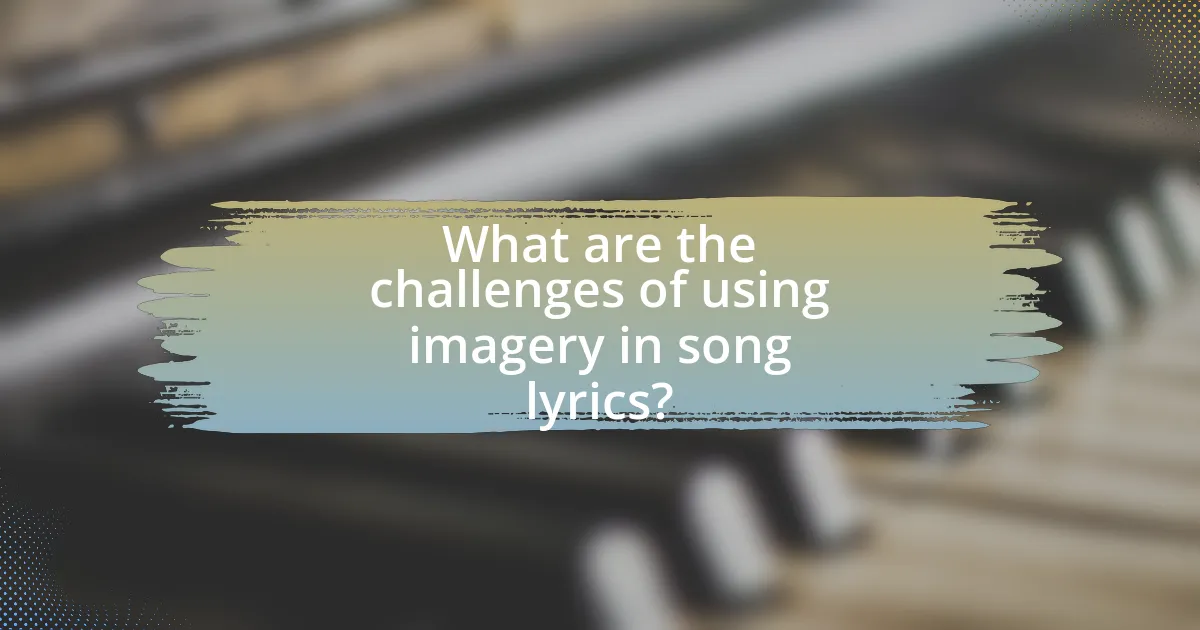
What are the challenges of using imagery in song lyrics?
The challenges of using imagery in song lyrics include the risk of ambiguity, cultural misinterpretation, and the potential for over-complexity. Ambiguity arises when imagery is too abstract, making it difficult for listeners to grasp the intended meaning. Cultural misinterpretation can occur when imagery relies on specific cultural references that may not resonate universally, leading to confusion. Additionally, over-complexity can detract from the emotional impact of a song, as intricate imagery may overshadow the core message. These challenges highlight the need for careful consideration in the crafting of lyrical imagery to ensure clarity and connection with the audience.
What pitfalls should songwriters avoid when using imagery?
Songwriters should avoid clichés when using imagery, as they can make lyrics feel unoriginal and uninspired. Clichés dilute the emotional impact of a song, leading to a lack of connection with the audience. For instance, phrases like “heart of gold” or “dancing in the rain” are overused and fail to evoke fresh emotions. Additionally, songwriters should steer clear of overly complex imagery that confuses listeners, as clarity is essential for effective communication in lyrics. Research indicates that clear and relatable imagery enhances listener engagement, making it crucial for songwriters to balance creativity with accessibility.
How can overuse of imagery detract from a song’s message?
Overuse of imagery can detract from a song’s message by overwhelming the listener and obscuring the core theme. When a song employs excessive imagery, it can create confusion, making it difficult for the audience to grasp the intended emotional or narrative focus. For instance, if a song is filled with numerous metaphors and vivid descriptions, the listener may become lost in the details rather than connecting with the underlying message. This phenomenon is supported by studies in music cognition, which indicate that clarity in lyrics enhances listener engagement and emotional resonance. Therefore, while imagery can enrich a song, its overuse can lead to a dilution of the message, ultimately hindering effective communication.
What are the risks of using obscure imagery in lyrics?
The risks of using obscure imagery in lyrics include potential misinterpretation and alienation of the audience. When lyrics contain ambiguous or complex imagery, listeners may struggle to grasp the intended meaning, leading to confusion. This confusion can result in a disconnect between the artist and the audience, as evidenced by studies showing that clarity in lyrics often enhances listener engagement and emotional connection. For instance, a survey conducted by the National Endowment for the Arts found that 70% of respondents preferred songs with clear narratives over those with abstract imagery. Therefore, while obscure imagery can be artistically intriguing, it poses significant risks to audience comprehension and connection.
How can songwriters balance imagery with clarity?
Songwriters can balance imagery with clarity by using vivid yet straightforward language that evokes strong visuals without obscuring the song’s message. This approach allows listeners to engage emotionally while still understanding the narrative. For instance, employing specific, relatable images—like “the sun setting over the ocean”—creates a clear picture while maintaining lyrical depth. Research indicates that effective imagery enhances listener connection, as shown in a study by the University of Southern California, which found that songs with clear imagery are more memorable and impactful. Thus, songwriters should focus on precise imagery that complements the song’s themes, ensuring clarity remains intact.
What strategies can help maintain lyrical clarity while using imagery?
To maintain lyrical clarity while using imagery, songwriters should focus on using specific and relatable images that evoke clear emotions or ideas. This strategy ensures that listeners can easily connect with the imagery presented in the lyrics. For instance, employing concrete nouns and vivid verbs can create strong visual associations, making the imagery more accessible. Additionally, maintaining a consistent theme throughout the song helps anchor the imagery, allowing listeners to follow the narrative without confusion. Research indicates that songs with clear imagery often resonate more with audiences, as they facilitate emotional engagement and understanding.
How can feedback from listeners guide effective imagery use?
Feedback from listeners can guide effective imagery use by providing insights into how well the imagery resonates with the audience’s emotions and experiences. When listeners express their interpretations and emotional reactions to specific imagery in song lyrics, artists can identify which images evoke strong connections and which do not. For instance, a study by the University of Southern California found that songs with vivid imagery that listeners relate to tend to achieve higher emotional engagement and popularity. This feedback loop allows artists to refine their use of imagery, ensuring it aligns with the audience’s perceptions and enhances the overall impact of the lyrics.
What practical tips can enhance the use of imagery in songwriting?
To enhance the use of imagery in songwriting, songwriters should incorporate specific sensory details that evoke emotions and create vivid mental pictures. Utilizing metaphors and similes can deepen the imagery, allowing listeners to connect more profoundly with the lyrics. For instance, comparing a feeling to a tangible object, like saying “her smile was a sunrise,” paints a clear picture and evokes warmth. Additionally, focusing on concrete nouns and active verbs can make descriptions more dynamic and relatable. Research indicates that songs with strong imagery often resonate more with audiences, as they stimulate the imagination and enhance emotional engagement.
